Oct 18, 2025
How to Speed up Hiring with Automated Candidate Screening (+15 Tools to Try)
Automated candidate screening uses AI to analyze resumes, rank applicants, and speed up hiring while reducing bias and improving accuracy.
Automated Candidate Screening is crucial in recruitment automation because it combines resume parsing, candidate matching, and AI screening within your applicant tracking system to identify strong fits faster and with less human bias. In this article, you will find practical tips on using automated resume review, candidate ranking, and predictive hiring signals to cut manual screening work and hire top-quality candidates faster and more efficiently.
Noxx's AI recruiter helps by automating shortlist creation, candidate scoring, and interview scheduling so your team spends time on conversations, not paperwork, and achieves fairer, faster hiring outcomes.
Table of Content
What Is Automated Candidate Screening Anyway?

Automated candidate screening is the use of software to review and filter job applicants at scale. It replaces the manual first pass with systems that parse resumes, extract structured candidate data, score and rank applicants, and match skills to job requirements.
Technologies that enable this include artificial intelligence, machine learning, natural language processing, optical character recognition, and named entity recognition. Common outcomes are a standardized candidate profile, a prioritized shortlist, and integration with an applicant tracking system and sourcing tools.
From Haystacks to Magnets: Why Automation Helps
Trying to screen a mountain of resumes manually is slow and error-prone. Automation acts like a magnet that surfaces the candidates with the closest skill match. Early systems relied on exact keyword matching, which meant resumes not using one specific term could be discarded even when the experience matched. Modern systems use context-aware models to recognize and surface related terms and transferable skills.
The Shift from Manual to Automated: Changing Recruiter Roles
Recruiters still add judgment and human connection, but automation shifts their focus away from administrative sorting. Automated screening allows talent acquisition teams to focus on engaging top candidates, building relationships, conducting in-depth interviews, and developing targeted sourcing strategies for hard-to-fill roles. Automation scales review and enforces consistent screening criteria, freeing recruiters to act as strategists and candidate advocates.
Manual vs Automated Screening: Side by Side
Speed: Manual review can take days or weeks for a high-volume role; automated screening processes thousands of applications in minutes.
Efficiency: Manual first passes burn human hours; automation converts resumes into structured data and reduces repetitive work.
Consistency: Human reviewers can vary due to fatigue and bias, whereas automation applies the same rules whenever configured correctly.
Scalability: Manual screening fails as applicant volume grows; automated approaches scale without loss of throughput.
Candidate experience: Manual processes can create long wait times and lead to drop-off; automation enables faster responses and more transparent communication.
Focus: Manual work centers on sorting and filtering; automated systems enable strategic outreach and assessment design.
How Screening Systems Work: Inside the ATS Engine
At the core sits the applicant tracking system, which stores applicant records and orchestrates screening workflows. When a resume arrives, the ATS parses it, extracts fields, enriches the profile with skills taxonomy tags and past employer data, and runs matching algorithms against the job requisition. The ATS also manages assessments, interview scheduling, and reporting so recruiters can trace the flow from application to hire.
Parsing and Extraction: Turning Resumes into Data
Resume parsing converts free-form documents into discrete data points such as contact details, job titles, employment dates, education, and skills. Parsing engines combine pattern recognition, named entity recognition, and rules-based extraction to populate a standardized candidate profile.
OCR handles scanned documents and image PDFs, enabling structured data to be created across file formats. Clean structured profiles make comparisons fair and feed downstream matching logic.
Skills and Assessment Matching: Validating What Matters
Automated systems match listed skills to job requirements using a skills taxonomy and synonyms mapping. Many platforms add assessment steps like coding challenges, case exercises, and language or cognitive tests to validate capabilities. Automated interview tools and AI-led assessments can evaluate communication, problem-solving, and other traits not apparent on a resume. These assessments enrich the profile, creating a more reliable pre-vetted shortlist.
Matching and Scoring: How Candidates Get Ranked
Matching engines compare candidate profiles to mandatory qualifications and preferred skills. They apply screening rules such as required licenses or minimum years of experience, then assign weighted points to preferred skills and certifications.
Modern systems use semantic analysis so that related skills cluster together and equivalent phrases map to the same competency. The result is a match score for each candidate, which produces a prioritized ranking for recruiter review.
Configuration Risk: When Automation Misfires
If the system is too rigid, it filters out qualified people. Poorly designed keywords, narrow Boolean rules, or a mismatch between the job profile and the skills taxonomy can exclude talent.
Many employers report that qualified candidates are filtered out due to formatting or wording issues, and about 70 percent of resumes can be rejected before a human sees them. With most large employers using an ATS, careful configuration and ongoing monitoring are necessary to avoid systemic exclusion.
Using AI for Smarter Matching: From Rules to Learning Systems
AI shifts screening from fixed rules to learned patterns. Machine learning models train on historical hires and performance data to identify traits that correlate with success.
Classification models, recommender systems, and clustering algorithms can surface candidates who are likely to succeed even when career paths do not match the job description exactly. AI also enables dynamic ranking and continuous improvement as more hiring outcomes feed the model.
Semantic Analysis: Reading Meaning Not Just Words
Semantic analysis and contextual embeddings let systems understand meaning rather than exact text matches. The screening engine recognizes that project planning, product roadmap development, and Scrum facilitation are related competencies for a project management role.
This reduces false negatives that occur when job titles or phrasing differ across industries, helping to find transferable talent.
Predicting Success: Analytics That Forecast Potential
Advanced analytics use historical employee data to identify predictors of performance and retention. Predictive models weigh variables such as career mobility, skill depth, assessment results, and prior role progression to estimate the likelihood of success. These predictions help prioritize candidates who not only meet the job criteria but also align with the attributes of top performers in the company.
Culture and Growth Fit: Screening for Long-Term Fit
Screening systems can score candidates for cultural fit and growth potential by analyzing language patterns, responses to situational questions, and behavioral assessment outputs. Natural language processing can detect indicators of collaboration, leadership, and innovation. Matching for culture and adaptability reduces turnover risk and supports internal mobility by identifying people who can grow across roles.
Bias Mitigation and Fairness: Designing for Equity
Automation can reduce unconscious bias by applying consistent criteria, but models trained on biased historical data will reproduce past patterns. Techniques such as anonymized screening, fairness constraints in models, and ongoing bias audits help reduce adverse impact. Human oversight remains necessary to validate model decisions and to adjust criteria that unintentionally disadvantage groups.
Candidate Experience and Communication: Faster, Clearer Engagement
Automated screening accelerates feedback loops through status updates, interview invites, and assessment scheduling. Chatbots and computerized messages can answer routine candidate questions, improving transparency.
At the same time, design choices matter, such as impersonal auto rejections and opaque scoring, which damage the employer brand unless paired with human follow-up and clear guidance.
Integrations and Ecosystem: How Screening Fits into Talent Tech
Screening rarely operates alone. It connects to sourcing platforms, candidate relationship management systems, background check providers, and HRIS solutions. API integrations allow skills data and match scores to flow into pipelines for internal mobility, contingent workforce management, and workforce planning models, turning the output of screening into strategic talent intelligence.
Practical Governance: Rules, Monitoring, and Continuous Tuning
Effective deployment requires governance. Define required versus preferred criteria, track false negative rates, monitor demographic outcomes, and run A/B tests on scoring thresholds. Regular audits and feedback loops from recruiters and hiring managers keep the model aligned with business needs and help refine the skills taxonomy and assessment mix.
Questions to Ask Before You Automate Screening
What are the non-negotiables for this role?
How will the system measure transferable skills?
Which assessments will validate critical abilities?
Who reviews candidates filtered out at the margin?
How will you monitor for bias and maintain human oversight?
Asking these questions shapes a configuration that supports hiring goals and protects candidate experience.
Metrics to Track After You Turn It On
Time to first response, interview to offer ratio, quality of hire indicators, false negative rate, diversity outcomes, and candidate satisfaction scores provide actionable insight into whether screening improves hiring. Use these metrics to adjust thresholds, retrain models, and refine assessments so the system better aligns with your hiring outcomes.
Related Reading
Benefits of Automated Candidate Screening

In many markets, they are off the market in about ten days. Manual resume review turns that window into a threat. Automated candidate screening and recruitment automation change the math by using resume parsing, applicant tracking system filters, and screening algorithms to process large applicant pools in minutes.
Faster Shortlisting
Candidate shortlisting and automated resume screening rank and score applicants immediately against job criteria. Recruiters can start outreach within hours, not days, which increases interview velocity and keeps momentum with passive talent.
Reduced Candidate Drop Off
A responsive process keeps top performers engaged. Automated emails, immediate status updates, and rapid pre-screening prevent candidates from going quiet or accepting a competing offer while your team finishes manual triage.
Increased recruiter productivity
Automation handles pre-screening, initial scoring, and basic skill checks so recruiters spend time on what matters most:
Interviewing
Closing
Integrations with applicant tracking systems and talent sourcing tools remove repetitive tasks and free hiring teams to be strategic.
Real-world Payoff
Companies using AI-driven screening and candidate ranking report cuts in time to hire of up to 75 percent, letting teams fill roles before competitors even make first contact.
Hire for Potential: Quality Over Checklist
Automated candidate screening uses skills matching, competency-based screening, and predictive hiring analytics to identify individuals with the right abilities, even when their job titles differ.
Broader Talent Pool
Intelligent parsing and semantic resume analysis find candidates with the right competencies rather than only matching exact keywords. A healthcare analyst with strong data skills can be surfaced for a fintech data role because the system recognizes core competencies.
Data-driven Insights
Candidate scoring, automated assessments, and structured interview guides give hiring managers objective evidence. This supports better interview planning and reduces guesswork when comparing finalists.
Better Hire Outcomes
Systems that combine automated assessments and video interview analysis deliver richer candidate profiles. For example, some companies found hiring managers were significantly more satisfied with hires after adopting AI interview analysis and data-driven screening.
Smarter workforce planning
Aggregated screening metrics and predictive analytics reveal which sourcing channels and assessment types yield higher success rates, improving future hiring decisions.
Fair Play: Remove Bias and Build a More Diverse Team
Unconscious bias often distorts manual review. Automated candidate screening supports fairer decisions by enforcing consistent, objective criteria.
Anonymize early stages: Configure systems to hide names, photos, and demographic fields during initial review. Blind screening concentrates attention on skills, experience, and measurable outcomes.
Ensure consistent rules: Screening algorithms apply the same checklist and scoring rubric to every resume. That reduces individual subjectivity and ensures every application receives an equal first pass.
Focus on merit: Use structured assessments and competency tests to evaluate what candidates can do. Standardized scoring puts real ability at the center of selection.
Audit and tune for fairness: Regularly review model outputs, test for disparate impact, and adjust criteria or training data where needed. Combining human oversight with unbiased screening tools prevents algorithmic drift and supports compliance.
Candidate experience benefits: Clear automated communications, standardized evaluations, and predictable steps make the process transparent for applicants and support diversity and inclusion goals through fair treatment across the candidate journey.
How to Automate Candidate Screening: A Step-by-Step Guide

Create a visual map of every step from job requisition to offer acceptance. Use a whiteboard or a simple flowchart tool and label who owns each step, how long each step takes, and what systems touch the data.
Action checklist:
Log cycle times: Measure time to screen one application, time to schedule an interview, and time to move a candidate between stages. Track 30 to 50 hires to get reliable averages.
Tag repetitive tasks: Resume screening, interview scheduling, status emails, data entry into your ATS, and initial phone screens.
Interview recruiters and hiring managers for pain points. Ask what they spend most of their time on and what they would rather automate.
Map candidate touchpoints to assess candidate experience at each step, such as response time and feedback frequency.
Tool and integration audit:
Inventory current systems: Applicant tracking system, calendar tools, email, assessment platforms, background check vendor, and HRIS.
Check existing connectors and APIs for each system and note missing integrations.
List manual data handoffs and where Excel or email still acts as the glue.
Privacy and governance quick scan:
Confirm what candidate data you collect, where it is stored, and who can access it.
Verify consent capture and retention rules. Does your job application collect consent for automated screening and third-party checks?
Flag any regulatory requirements for your jurisdictions, such as GDPR or CCPA.
Pick AI Tools That Fit Your Workflow, Not the Other Way Around
Match tool capabilities to the specific bottlenecks you found.
Must have features:
Resume parsing with skills inference and semantic matching using natural language processing.
Candidate ranking and scoring that show why a profile scored well.
Automated assessments and structured interview templates.
Automated scheduling and calendar coordination that avoids double bookings.
Candidate engagement via chatbots or automated screening conversations.
Analytics and dashboards for time to hire, pipeline drop off, diversity metrics, and candidate NPS.
There are strong security and compliance controls for candidate data.
Vendor evaluation steps:
Run a compatibility test: confirm the tool can push and pull data to your ATS and calendar system via API.
Ask for a demo using your job descriptions and a sample resume dataset to see semantic matching in action.
Request documentation on data security, encryption, and data residency.
Check update cadence and roadmap to ensure ongoing improvements.
Sample selection criteria:
Cost per screened candidate and pricing model for volume.
Support for structured interviews, video interviewing, and pre-employment assessments.
Bias mitigation features include diverse training data and audit logs.
Scalability and SLA guarantees for peak hiring periods.
Install, Tune, and Run a Small Pilot First
Define what success looks like for the pilot and measure everything you can.
Define screening criteria:
Use a set of 10 to 20 successful past hires per role to extract must-have skills, preferred skills, and red flags.
Convert those into machine-readable rules and training examples for semantic matching.
Set initial threshold scores for auto-reject, human review, and auto-move-forward.
Secure integration and mapping:
Configure secure API connections and map fields between the AI tool and your ATS.
Validate parsing: check how the tool extracts skills, education, employment dates, and gap interpretation.
Build candidate consent flows and disclosures into the application process.
Pilot execution plan:
Pick one high-volume role or one department for 2 to 3 hiring cycles.
Start with the AI recommending actions rather than executing them automatically.
Track metrics daily in the pilot: Number of screened candidates, time saved per recruiter, response rates, quality of interviews scheduled, and hire rate from AI-recommended candidates.
Collect qualitative feedback from recruiters and candidates on communication and perceived fairness.
Tune models and playbooks:
Adjust thresholds and rerun training using false positives and false negatives from the pilot.
Refine assessment questions and structured interview rubrics based on interviewer feedback.
Create templates for automated candidate outreach that keep the tone personal and informative.
Measure, Audit, and Keep Decisions Explainable and Fair
Set a steady cadence to measure performance and to surface and fix issues before they become systemic.
Operational metrics to track:
Time to screen, time to interview, time to offer, and time to hire.
Candidate conversion at each funnel stage and reasons for candidate drop-off.
Diversity metrics across stages and hires by source and screening score.
Candidate satisfaction and recruiter satisfaction scores.
Model health and calibration:
Run bias audits monthly: Test model output on synthetic sets that vary gender, ethnicity, schools, and employment history.
Log model decisions and keep explanations that show which skills or phrases drove candidate ranking.
Use human in the loop for borderline cases and for any automatic rejections for the first 6 months.
Compliance and data governance:
Keep a record of data sources used to train or inform the model and the retention schedule for candidate records.
Store audit logs for decision tracing in case of disputes or regulatory review.
Publish clear job postings that disclose the use of automated candidate screening and explain how candidates can request human review.
Candidate experience and fallback paths:
Ensure automated messages include a path to reach a human recruiter.
Use automated interviews and chatbots to collect structured data, but allow opt-out for candidates who prefer live interaction.
Follow up low response rates with recruiter outreach and analyze outreach A/B tests to improve engagement.
Continuous improvement loop:
Re-train models quarterly using new hires labeled as successful or unsuccessful.
A/B test screening rules and assessment flows against control groups to quantify lift in quality of hire.
Schedule governance reviews with legal, privacy, and diversity leads to approve any significant changes
Related Reading
• Remote Developers Eastern Europe
• AI and Recruiting
• Remote Hiring Tools
• AI Recruiting Startups
• AI Recruiters
15 Best AI Solutions for Automated Candidate Screening
1. Noxx

Noxx runs automated candidate screening at scale to surface the top 10 candidates in seven days. Upload your job description and the AI recruiter parses over 1,000 applicants, applies skills assessment and resume parsing, and ranks the best matches so your hiring team focuses on interviews and culture fit.
Pay-Per-Hire AI Recruiting for Startups
Standout features include pay-only-on-hire pricing at three hundred dollars, an upfront salary expectation display, automated shortlisting, and candidate sourcing optimized for engineers, marketers, and sales roles at up to 70 percent below US rates.
Ideal use cases are startups and small teams that need fast, low-cost hiring with minimal recruiter overhead, aiming to shorten time to hire while keeping the cost per hire predictable.
2. MokaHR
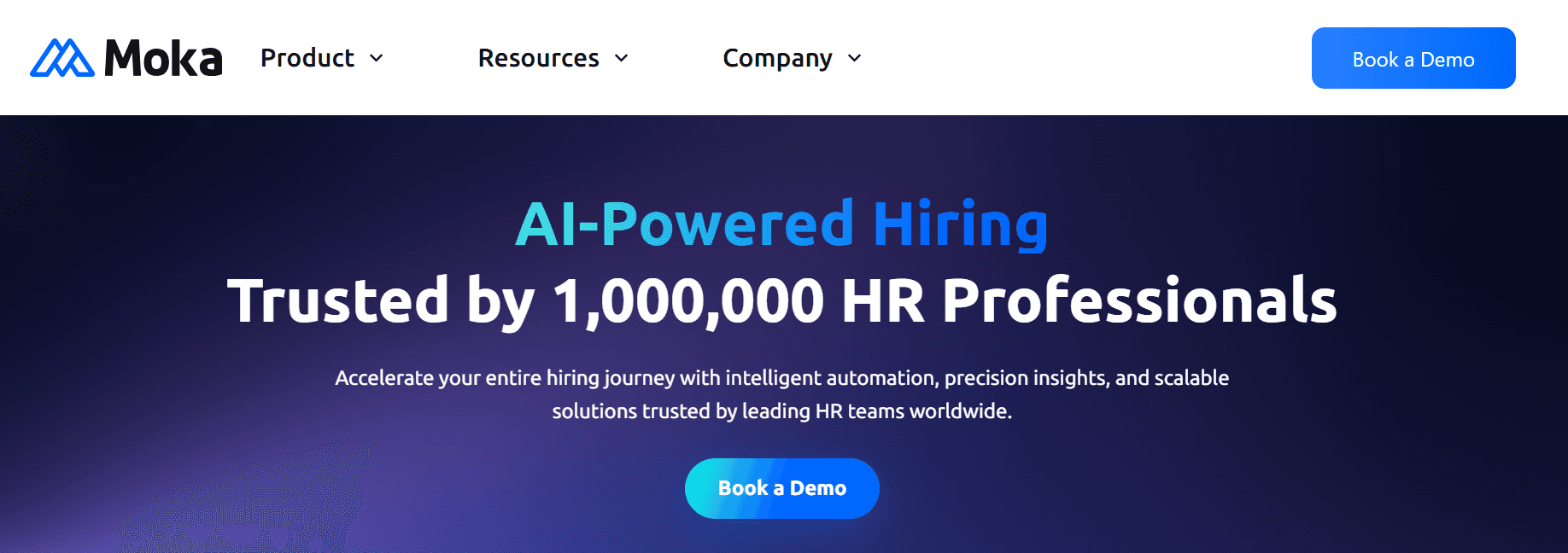
MokaHR automates resume parsing and candidate matching with machine learning tuned for high extraction accuracy and screening speed. It reads resumes with 95 percent parsing accuracy, boosting screening speed by 80 percent while identifying 20 percent more relevant candidates.
Standout features include continuous learning that improves with each hire, integrations with existing ATS, and workflow automation that reduces recruitment costs by up to 70 percent. Ideal for HR teams that need reliable resume parsing, faster automated shortlisting, and measurable screening efficiency gains.
Key metrics and case evidence you can use when measuring ROI:
Parsing Accuracy: 95 percent accuracy in extracting candidate information
Screening Speed: 80 percent faster candidate screening process
Increase in Relevant Candidates: 20 percent more relevant candidates identified
Cost Reduction: Up to 70 percent reduction in recruitment costs
Deloitte Study on AI Recruitment: 20 percent improvement in quality of hires
Unilever Case Study: 75 percent reduction in time to hire
Hilton Worldwide Case Study: Over 85 percent reduction in manual screening time
MokaHR also adapts with each hire, improving candidate matching over time.
3. iCIMS and HireVue
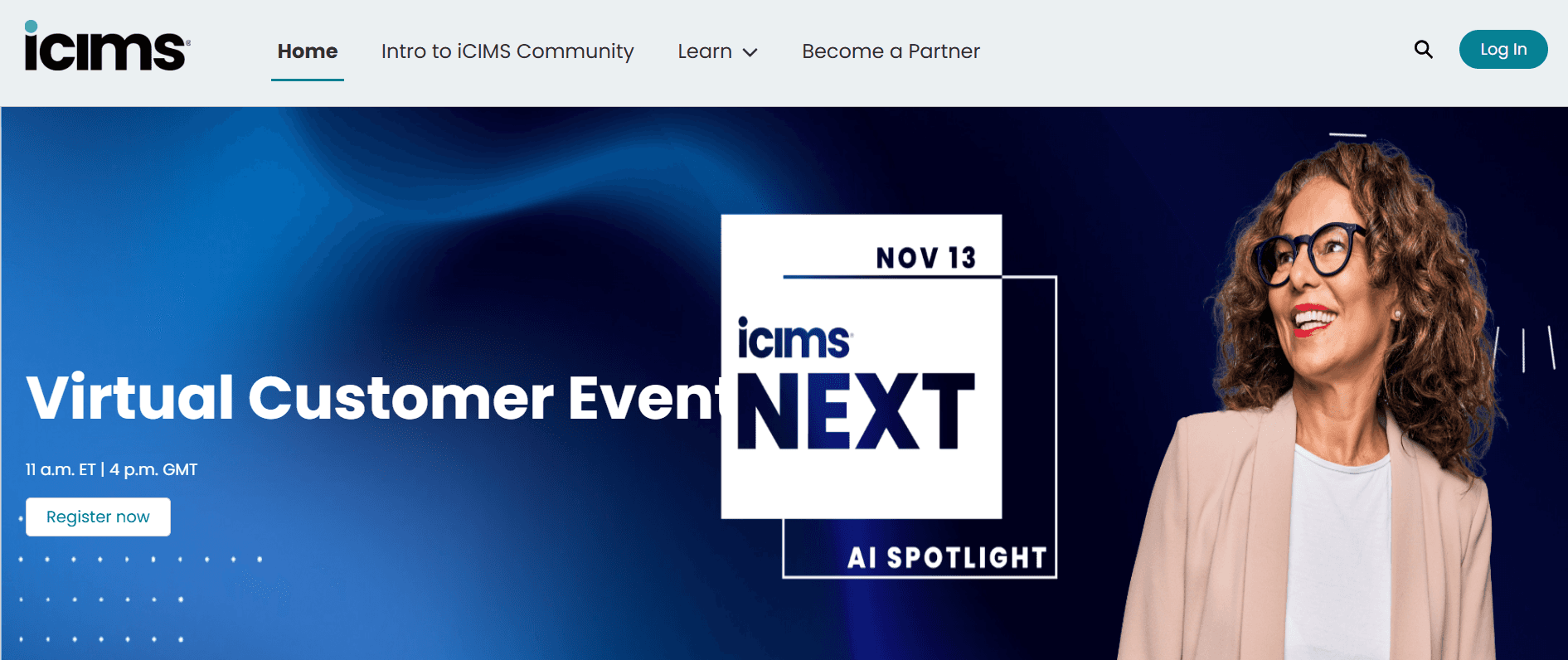
iCIMS provides an enterprise applicant tracking system focused on candidate matching, internal mobility, and fairness in hiring. The platform applies AI ranking and predictive analytics to automate candidate screening workflows, speeding hiring and improving internal talent moves.
Standout features are high-volume hiring support, career site integrations, advanced reporting, and a reported 282 percent return on investment with jobs filled about 22 percent faster. Use iCIMS when you need an ATS that scales, enforces consistent screening processes, and tracks quality of hire metrics across teams.
HireVue Overview and Value
HireVue specializes in video interviewing and asynchronous candidate assessment to streamline initial screening and reduce scheduling friction. The platform supports one-way video interviews and AI-assisted scoring to remove repetitive live screening calls, helping companies hire faster and maintain candidate engagement.
Reported improvements include up to a 33 percent reduction in time to hire, up to a 50 percent reduction in initial screening time, 58 percent less time spent on scheduling, a 67 percent boost in recruiter productivity, and strong candidate satisfaction scores near 82 percent. Choose HireVue for roles that benefit from behavioral assessment via video and when you need to scale initial screening without sacrificing consistency.
4. Qureos
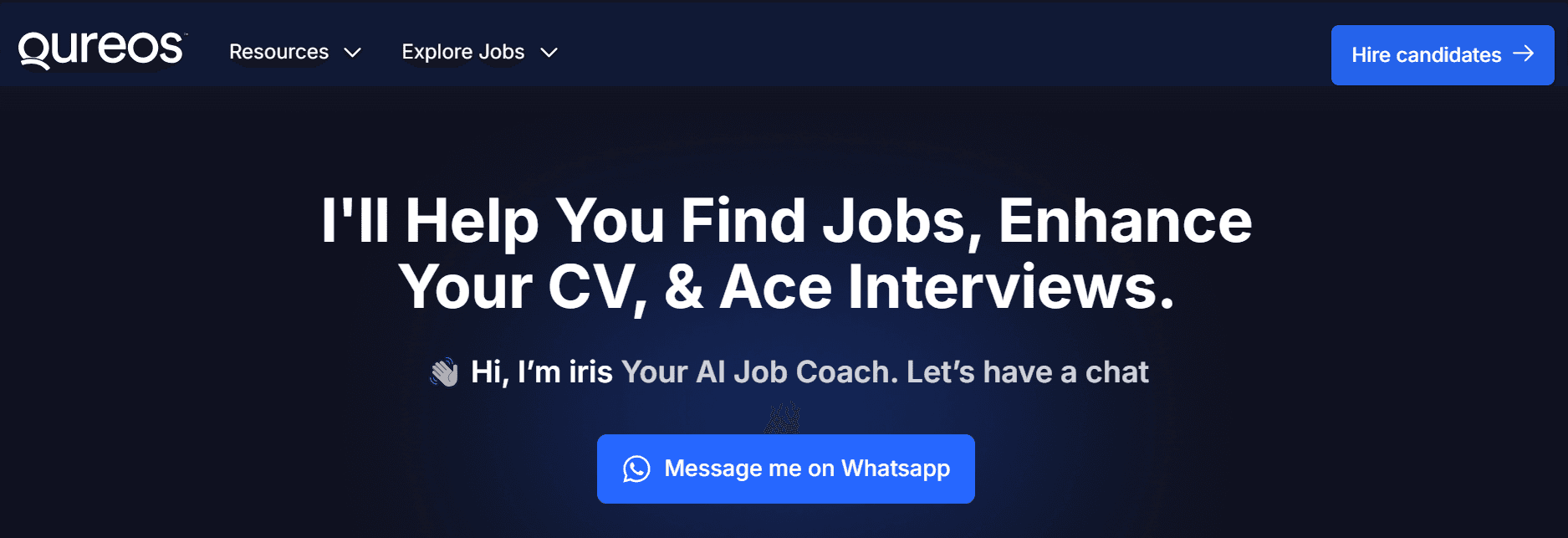
Qureos focuses automated candidate screening on skills and performance rather than resume signals. The platform guides applicants through skill checks, provides instant answers via a digital assistant, and returns fast feedback so candidate engagement stays high.
Standout features include skills-based matching, automated candidate coaching, and batch hiring support for technical and project-based roles. Use Qureos when you want to reduce bias, prioritize skills assessment, and maintain candidate engagement through the screening funnel.
5. Avature
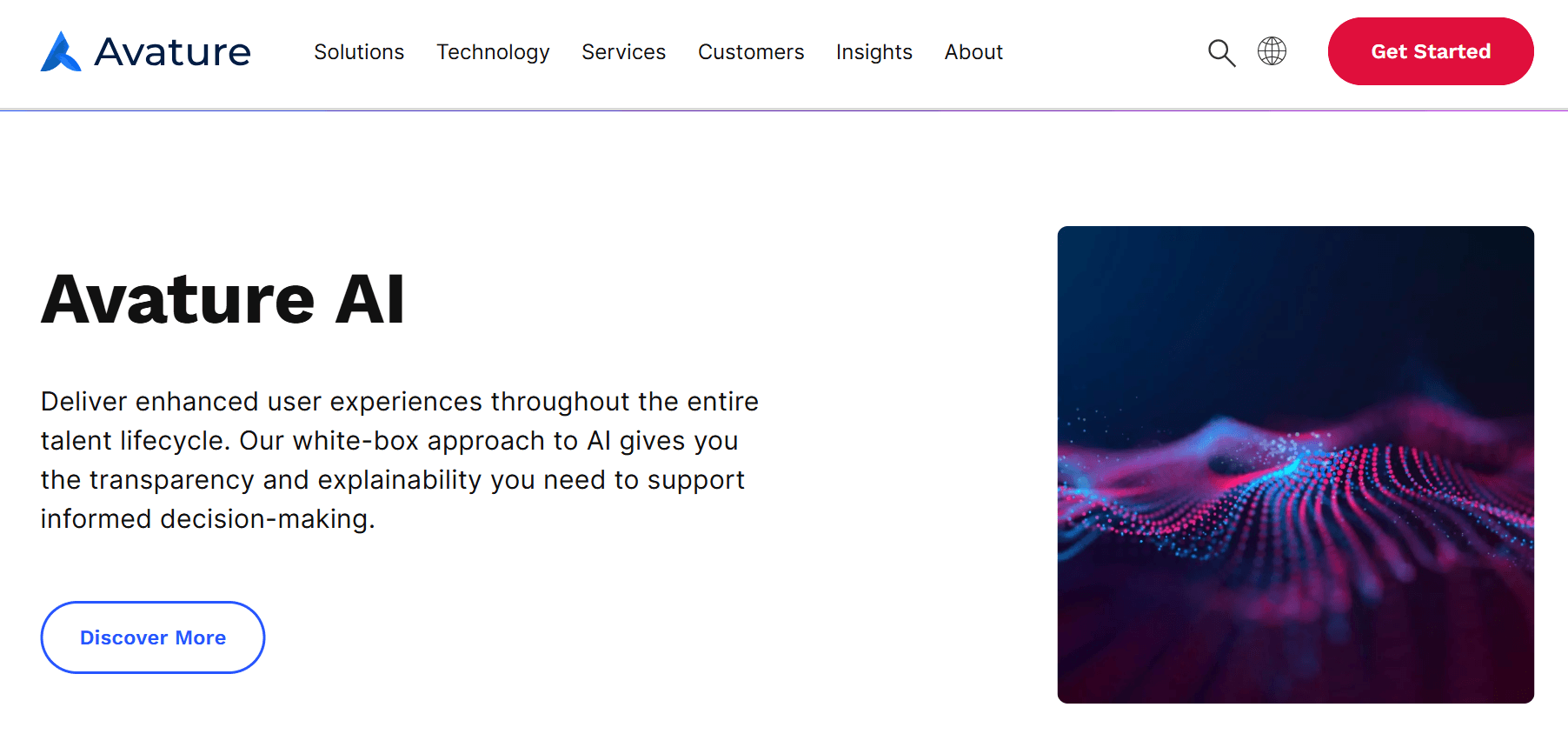
Avature offers a highly configurable talent acquisition platform that supports complex workflows and enterprise-scale hiring automation. It scores candidates with AI, automates outreach, integrates with existing HR tools, and lets you tailor candidate screening workflows to specific business needs.
Standout capabilities include deep customization, campaign-style outreach, and strong CRM features to build pipelines and internal mobility programs. Ideal for global HR teams that need flexible automation, multi-channel candidate engagement, and bespoke candidate assessment flows.
6. Filtered.ai
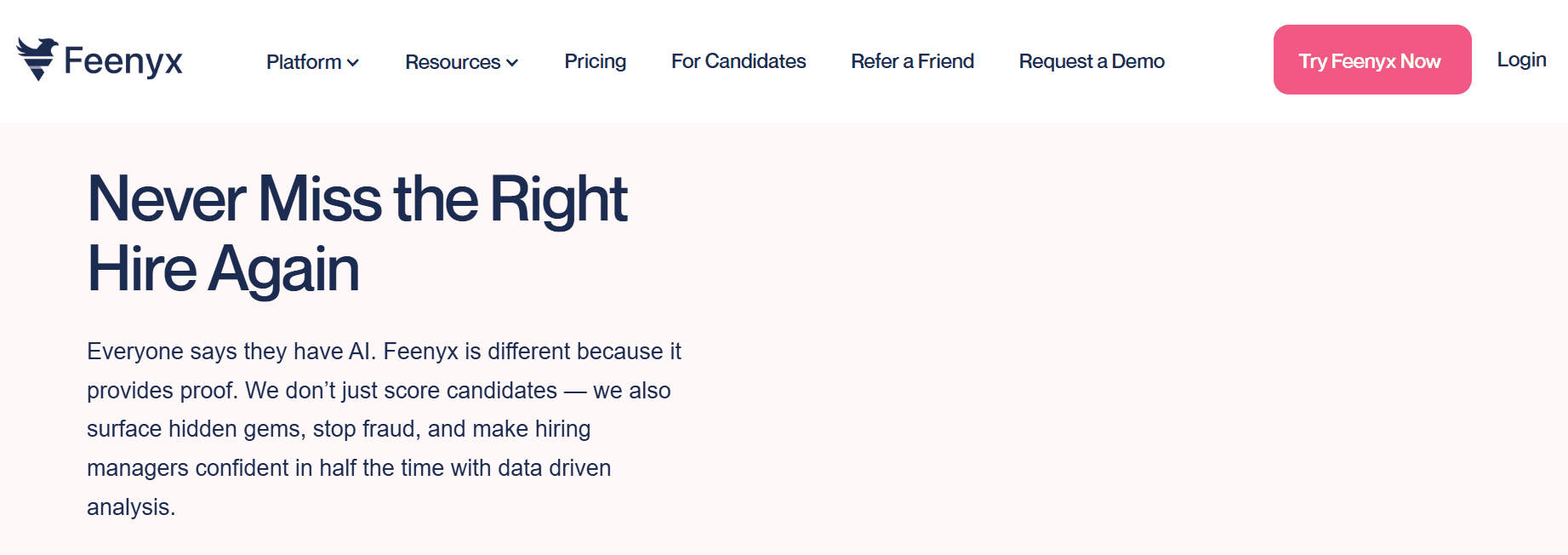
Filtered.ai applies skill and experience scoring to produce an automated shortlist that reduces manual resume review by about 75 percent. The system correlates assessment outcomes with on-the-job retention, showing a 30 percent increase in employees staying past one year.
Standout features include automated shortlisting, bias reduction controls, and insights into candidate fit that feed your talent pipeline. Use Filtered.ai for roles where screening efficiency and quality of hire matter, especially when you want to lower recruitment costs by roughly 40 percent while improving retention.
7. Hirebee
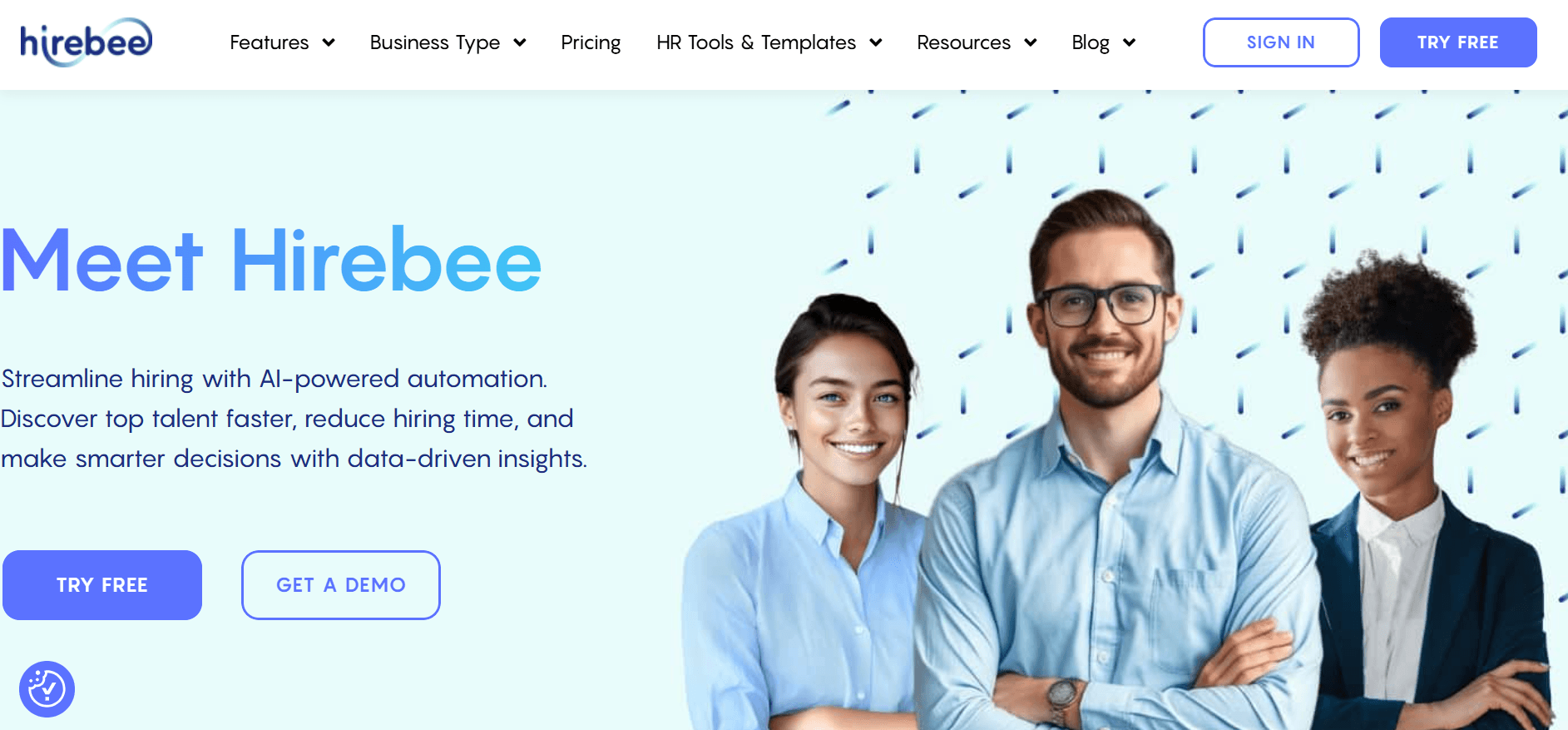
Hirebee speeds up screening by offering automated question collection across video, audio, and text, and cutting screening time by about 90 percent. It transcribes responses in over 90 languages, plugs into standard ATS systems, and provides workflow automation to raise hiring accuracy by about 40 percent.
Key features are flexible response formats, extensive language support, and ROI is often reported at over 300 percent within the first year. Hirebee is ideal for high-volume hiring where screening automation, multilingual candidate engagement, and fast evaluation are required.
8. Hirevire
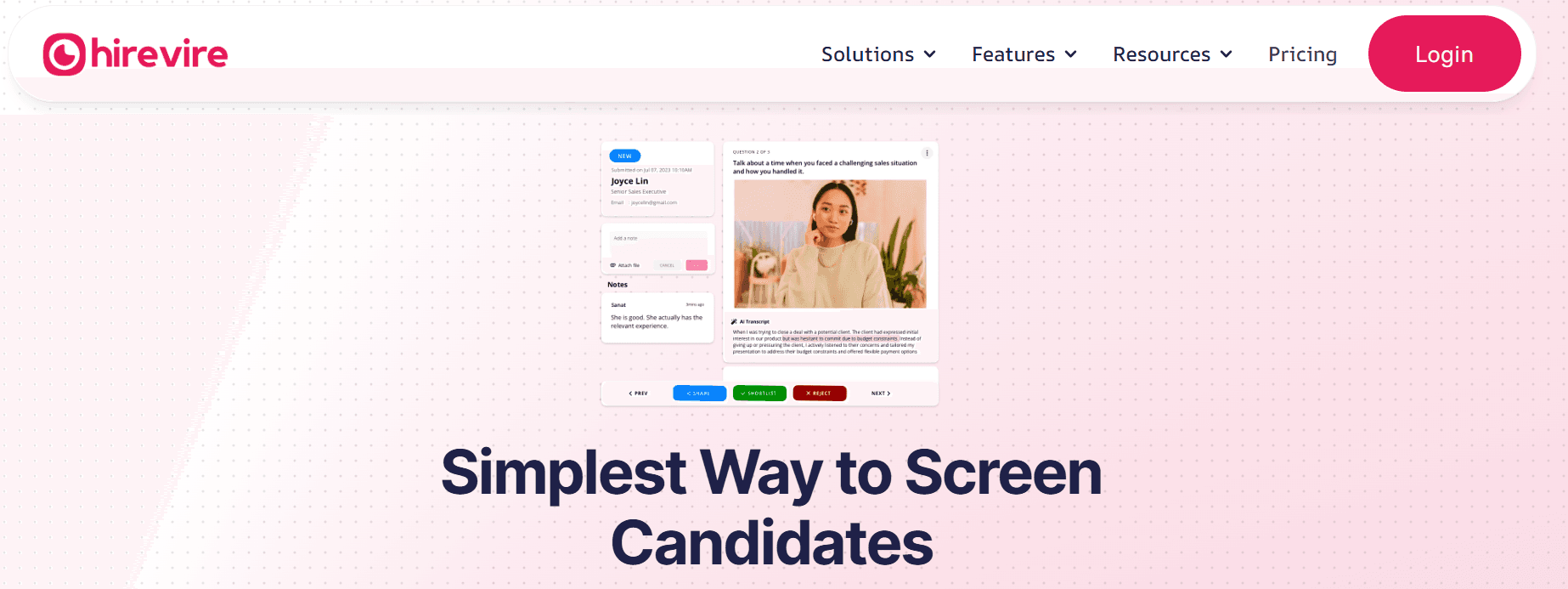
Hirevire provides asynchronous video, audio, and file-based candidate interviews with AI transcription and workflow automation. It accepts responses without candidate login, integrates with thousands of apps via Zapier, and includes branded career pages and automated email workflows.
Standout features are unlimited responses in base plans, strong mobile support, and extensive integration ability. Use Hirevire for cost-conscious teams that need scalable asynchronous interviews, simple candidate engagement, and API friendly screening automation.
9. SparkHire
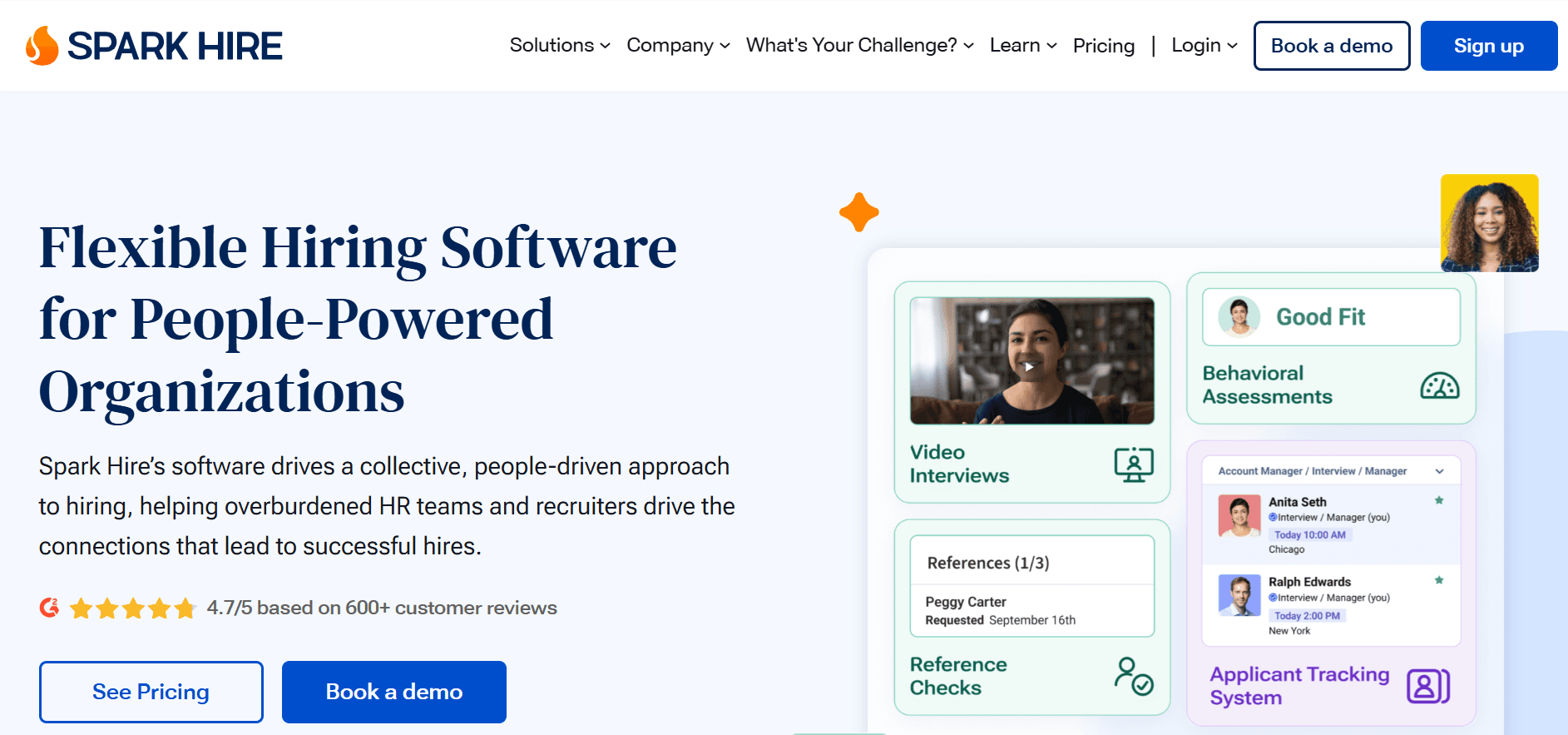
SparkHire centers on one-way and live video interviews combined with collaborative evaluation tools for hiring teams. It supports interview scheduling, question banks, basic ATS integration, and a mobile app for reviewers.
Standout capabilities are easy interview sharing, team scoring, and a focus on staffing agencies and medium-sized businesses. SparkHire is ideal for replacing live phone screens with recorded responses and maintaining a simple candidate assessment workflow.
10. Vervoe
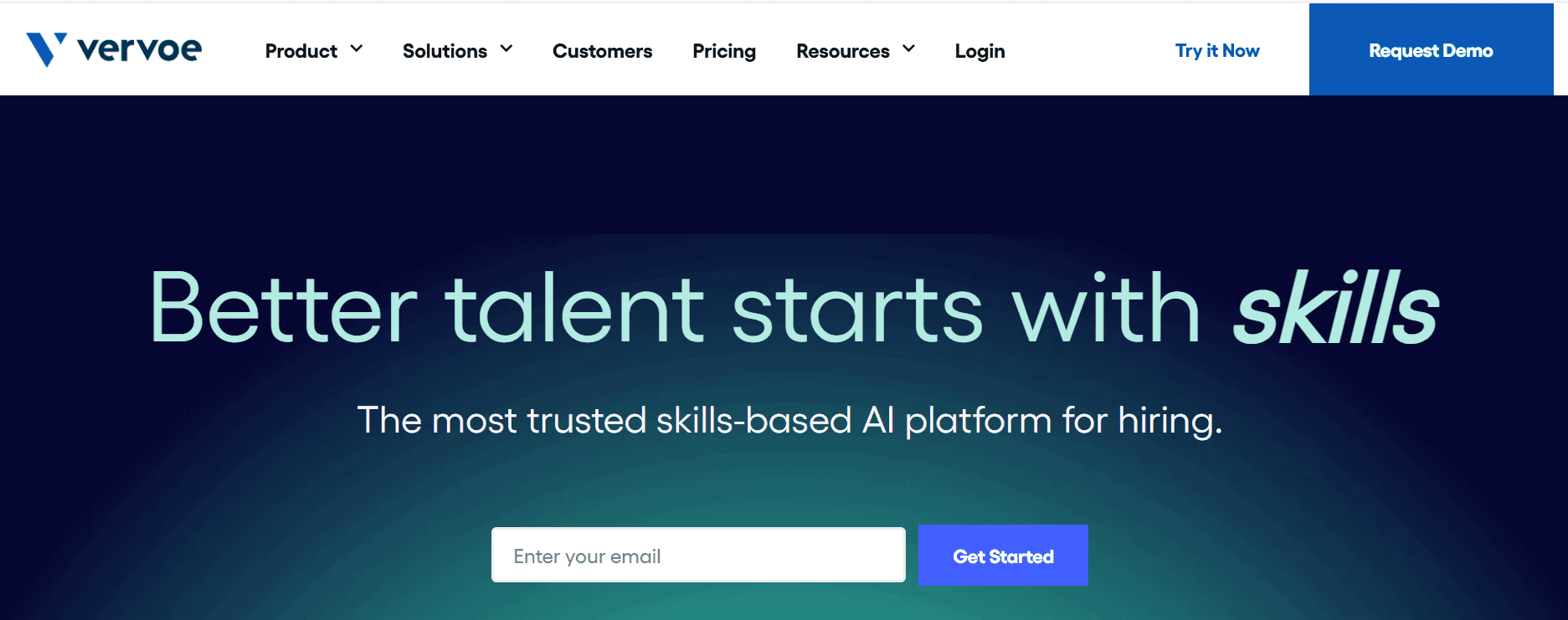
Vervoe automates skills assessment with AI-driven simulations and scoring to predict candidate performance. You can build customizable assessments, use role-specific templates, and apply automated scoring to prioritize applicants.
Key features include bias reduction tools, video interview capabilities, and performance prediction dashboards. Choose Vervoe when you need to base hiring decisions on demonstrated skill, reduce resume noise, and build a fair automated shortlisting process.
11. Criteria Corp
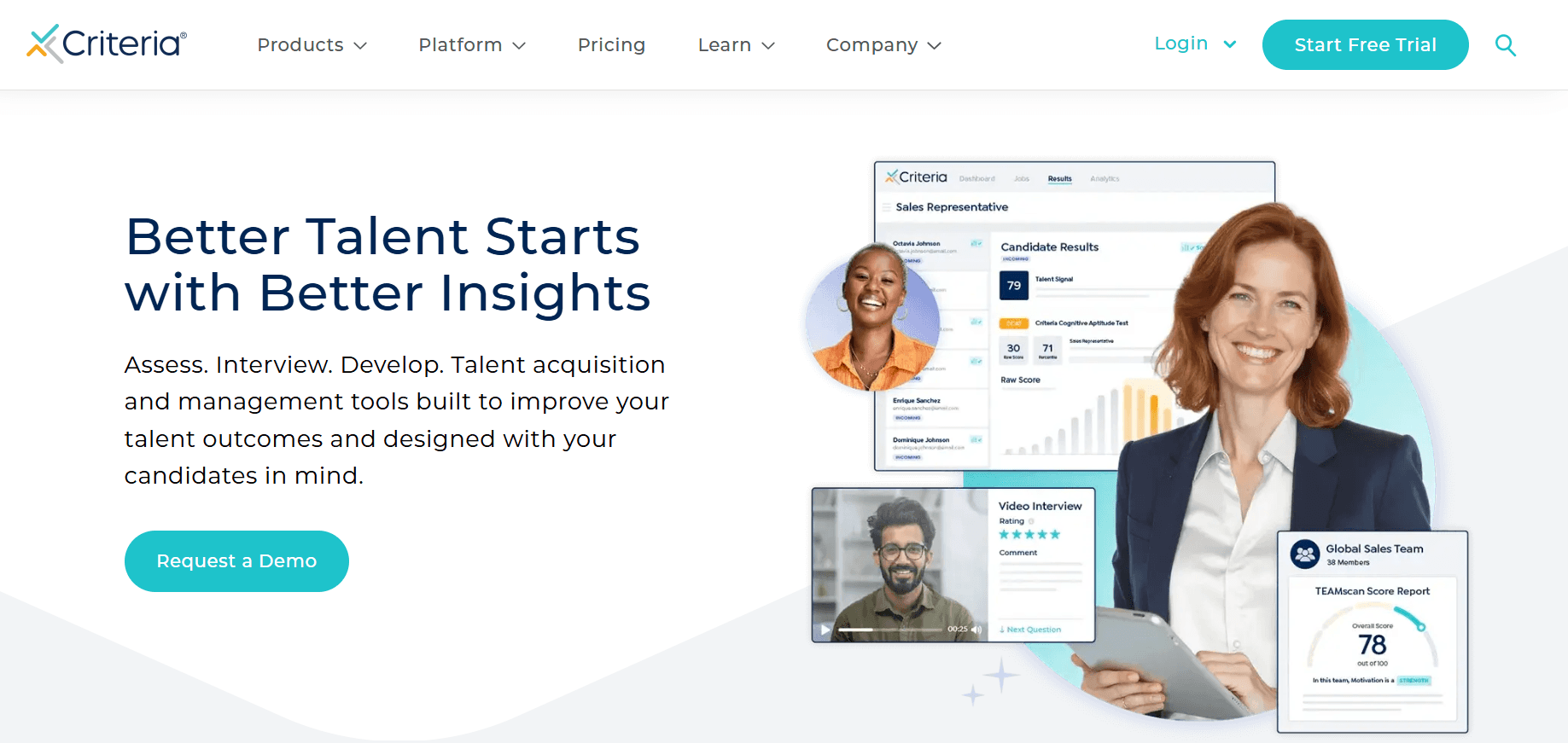
Criteria Corp offers cognitive aptitude, personality, emotional intelligence, and skills tests that tie to predictive analytics for hiring. The suite focuses on scientific validation and consistent assessment, with advanced analytics to help you compare candidates objectively.
Standout features include a vast library of validated tests, benchmarking tools, and reporting that support compliance and legal defensibility. Use Criteria Corp when you require measured, validated candidate assessment to support high-stakes hiring decisions.
12. Phenom
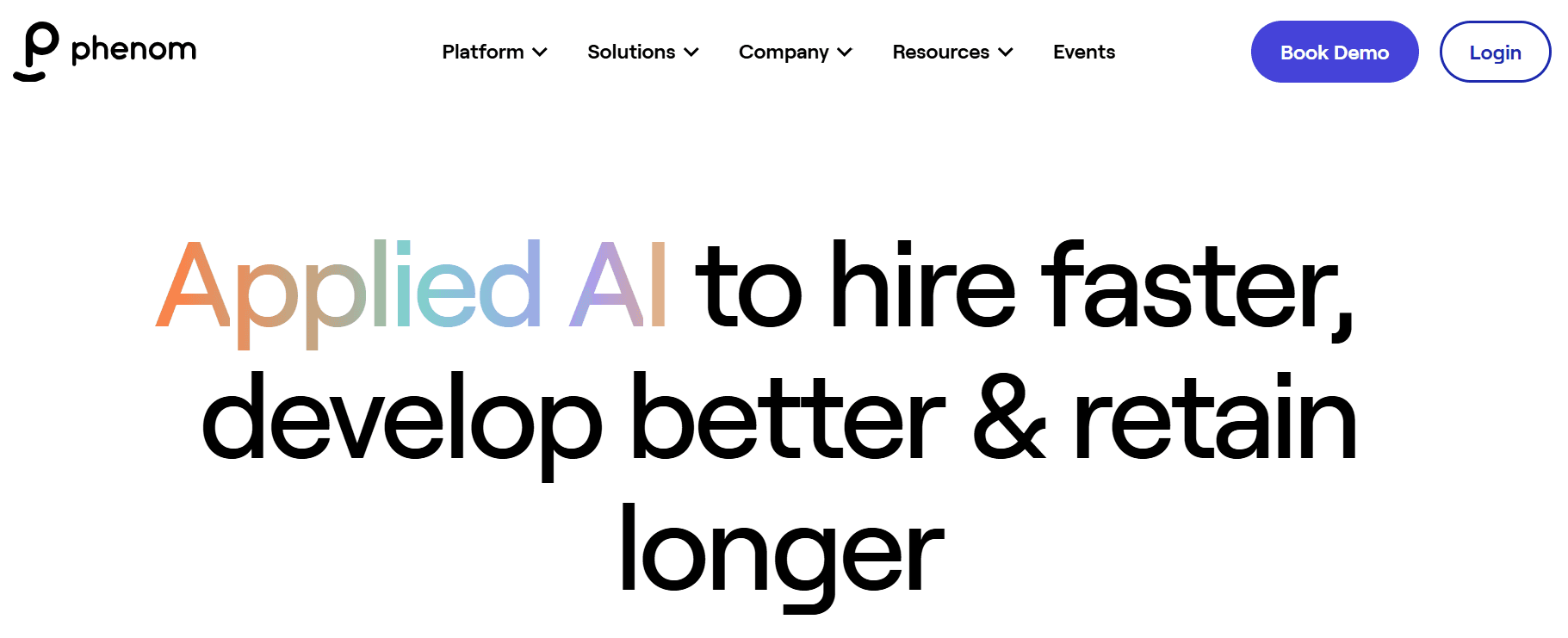
Phenom blends candidate experience, CRM, and internal mobility with one-way video assessments inside a broader talent management system. The platform enhances candidate engagement with chatbot integration, personalized career sites, and analytics that feed talent pipelines.
Standout features include deep CRM capabilities, internal mobility tools, and analytics that connect candidate screening to long-term talent outcomes. Phenom works for organizations that want screening automation tied directly to candidate experience and internal talent strategies.
13. BreezyHR
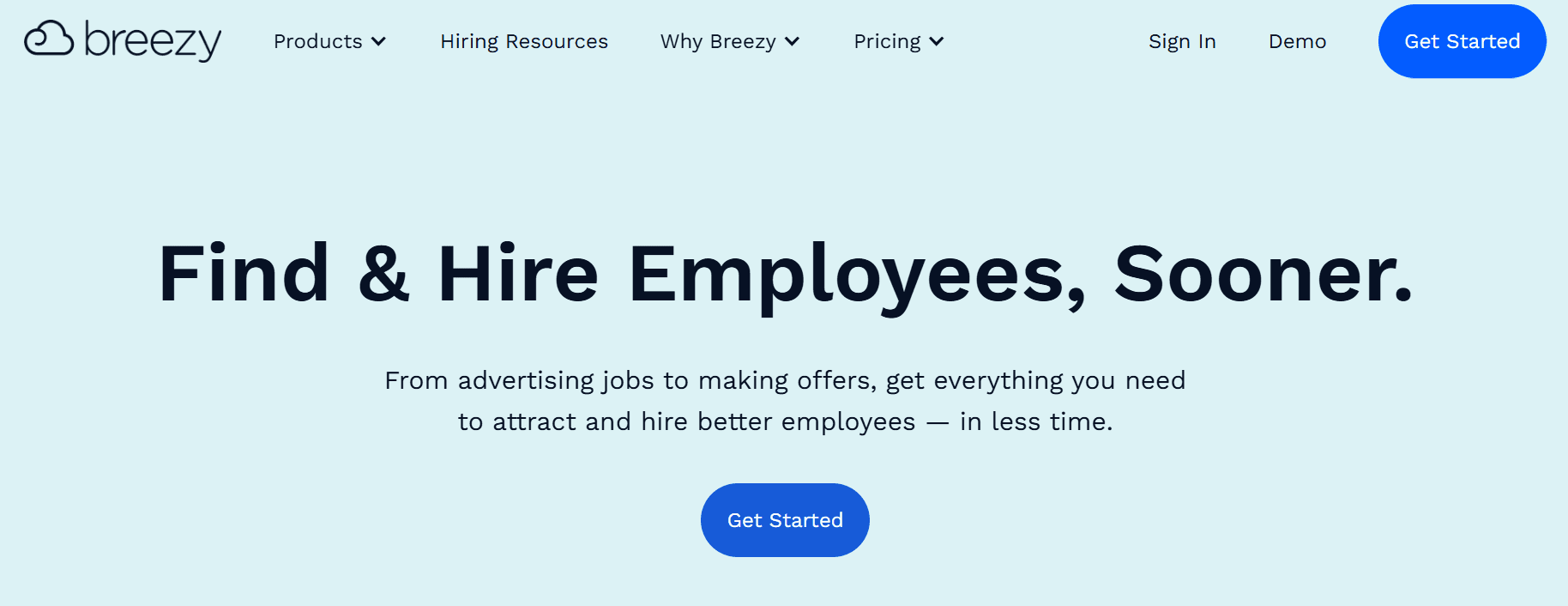
BreezyHR combines applicant tracking with video screening, Kanban-style pipelines, and automated job posting to speed hiring for small and medium-sized businesses. It includes interview scheduling, team collaboration, and a custom career portal to attract and move candidates through screening workflows.
Standout features are visual hiring boards, easy integration, and fast setup. BreezyHR fits teams that need a simple end-to-end ATS with built-in video interviewing and candidate engagement tools.
14. Workable
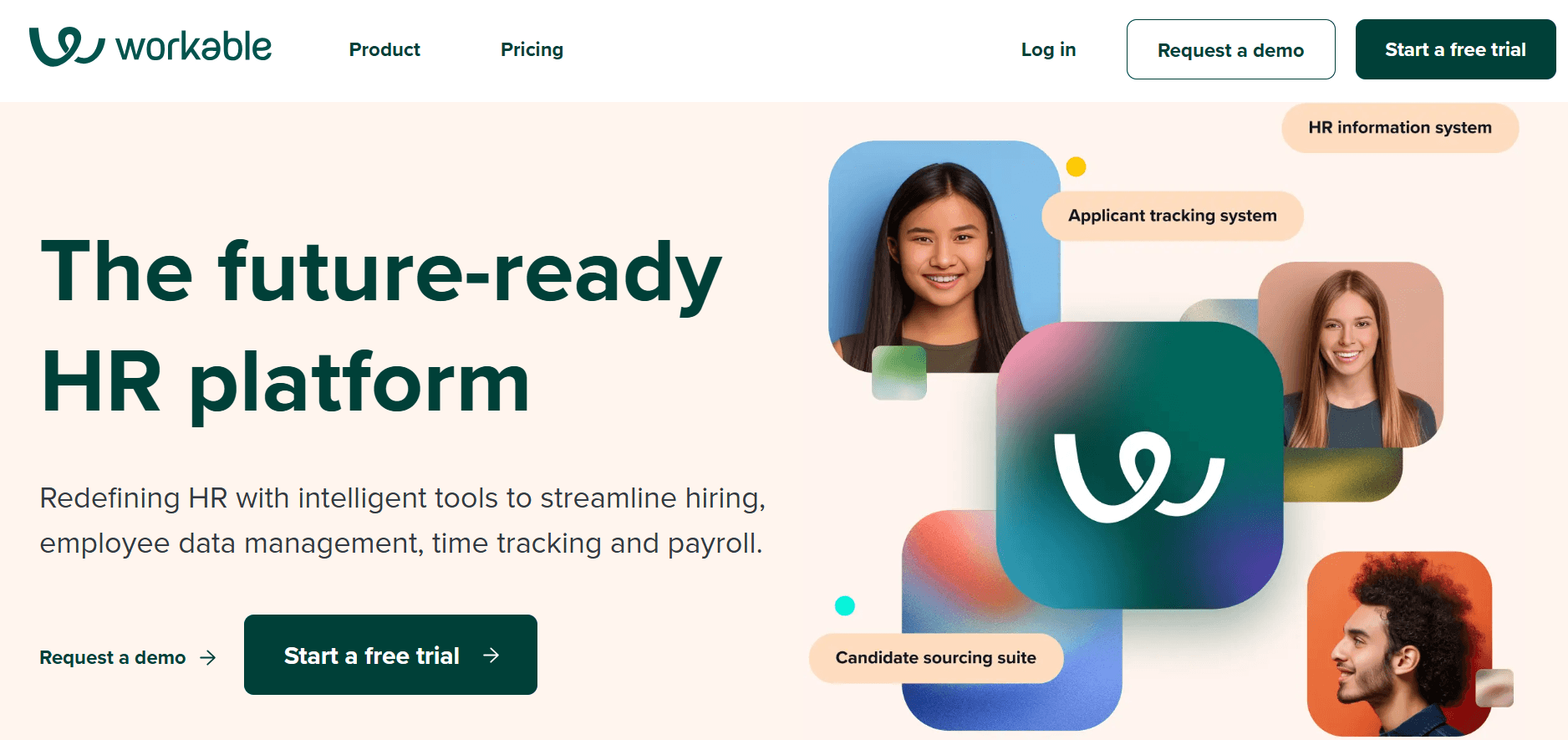
Workable offers AI-powered sourcing, candidate screening, and integrated video interview tools alongside templates and compliance features. It provides over seven hundred job description templates, automated workflows, and more than forty integrations to help scale hiring.
Standout features include AI job matching, sourcing Chrome extensions, and advanced reporting to measure screening efficiency and time to hire. Use Workable when you need an integrated platform that handles sourcing, automated shortlisting, and interview scheduling in one place.
15. Harver
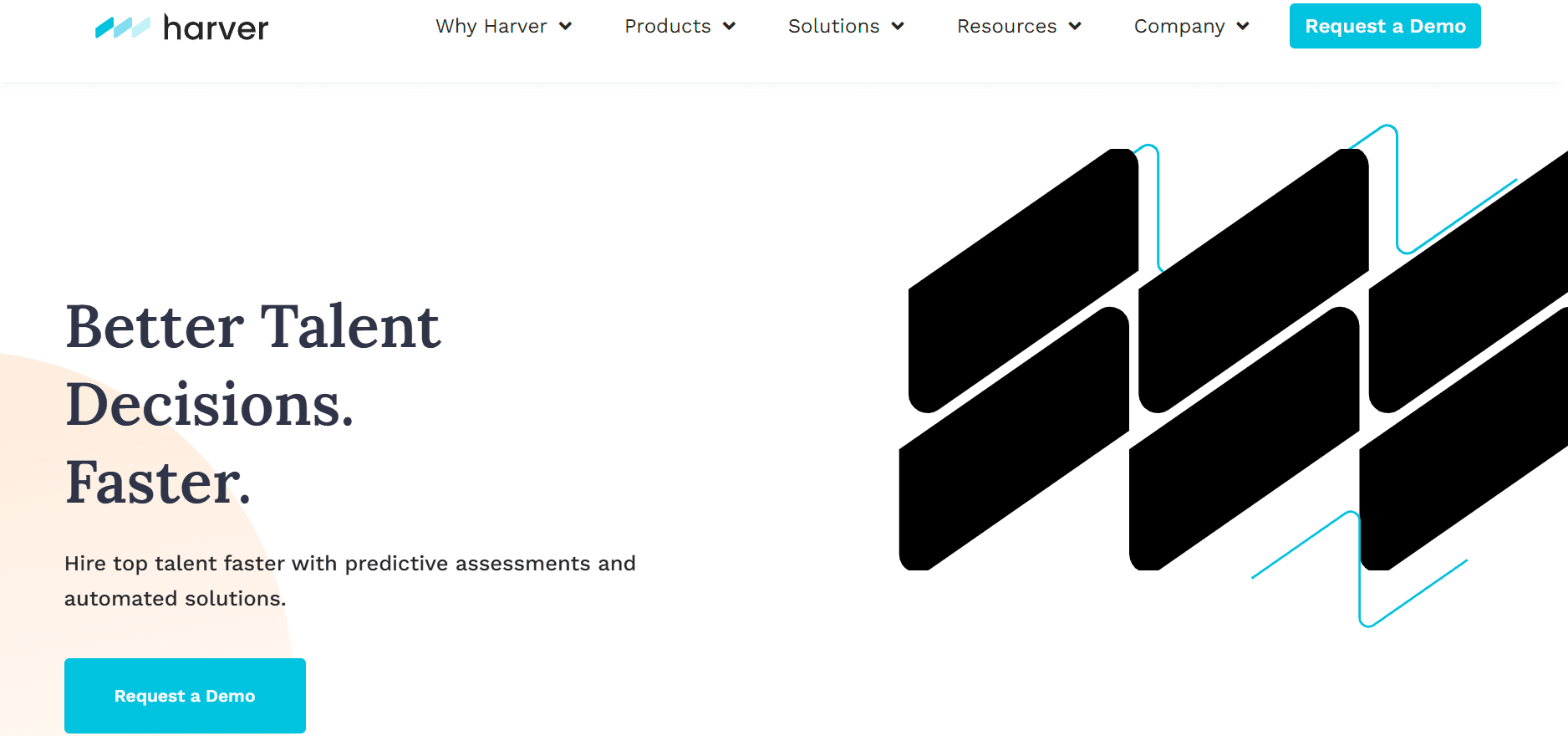
Harver focuses on high-volume, front-line, and customer-facing hiring by automating assessments, situational judgment tests, and realistic job previews to reduce attrition. It matches candidates to roles early, which improves retention and cuts selection bias through objective assessment.
Standout features are large-scale assessment libraries, automated candidate matching, and analytics for hiring operations. Harver is ideal for retail, hospitality, and customer service teams that need to scale screening automation while improving the quality of hire.
Upload a Job and Get 10 Candidates within 7 Days with Noxx (No Risk, No Upfront Fees)
Noxx identifies the top 10 candidates in seven days by conducting automated candidate screenings at scale. The system parses resumes, applies skill assessment models, and uses natural language processing to extract role fit and experience from CVs and cover letters. Screening algorithms score applicants, rank candidates, and generate a validated shortlist so hiring teams see only the best matches fast.
Automated Candidate Screening and AI Matchmaking: What Happens Under the Hood
Noxx combines resume parsing, applicant tracking integration, and machine learning candidate matching to convert a large candidate pool into a focused shortlist. The platform uses predictive analytics and candidate scoring to weigh skills, experience, and signals from work samples.
Structured pre-screening questions and automated assessments cut noise by qualifying for both technical skill and cultural fit. The result is an efficient candidate pipeline with reduced manual resume review.
Cost Model and Risk-Free Hiring: Pay Only When You Hire
Noxx charges $300 only when you actually hire a candidate sourced through the platform. No upfront fees and no expensive recruiter commissions. That shifts the risk away from you and aligns incentives with successful hires. The AI sources and qualifies candidates, then you choose the final hire and matching fee triggers.
Salary Transparency and Global Cost Savings
Noxx displays salary expectations up front for each candidate and recommends competitive compensation ranges by role and region. The platform helps you hire engineers, marketers, and salespeople at rates up to 70 percent below typical U.S. salaries while maintaining quality through skills testing and performance indicators. This gives you a predictable hiring cost and more precise budget planning.
Bias Reduction and Quality Controls in Automated Screening
Noxx applies normalization and blocking techniques to reduce bias in candidate ranking. The system anonymizes selected data fields, enforces consistent interview rubrics, and audits screening models with fairness checks. Recruiters can adjust weightings for skills, certifications, or experience and review flagged profiles before advancing candidates.
Integration, Reporting, and Candidate Experience
Noxx syncs with applicant tracking systems and calendar tools, automates interview scheduling, and keeps candidates informed with automated outreach. You get candidate engagement metrics, time to fill, and conversion rates in dashboards. The platform stores structured interview notes and assessment outcomes for compliance and future hiring decisions.
What You Need to Do: Upload the Job, Review Shortlist, Hire
You supply the job description and priorities. Noxx handles candidate sourcing, resume screening, automated interviews, and initial vetting. Your hiring team reviews the top 10, conducts final interviews, and selects the person who fits best. The interface lets you change filters mid-search and refresh the candidate pool instantly.
Security, Privacy, and Data Handling
Candidate data is stored with access controls and encryption. The platform documents consent for assessments and background checks, and retains audit logs for compliance. You can export candidate records to your HR systems or keep the process contained within Noxx.
Related Reading
• Toptal Alternatives
• Companies using AI for Recruitment
• AI Screening
• Toptal vs Gigster
• Andela Competitors
• Turing Alternatives

